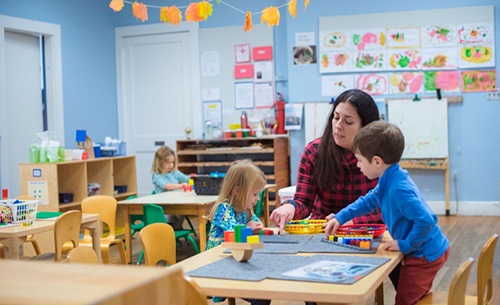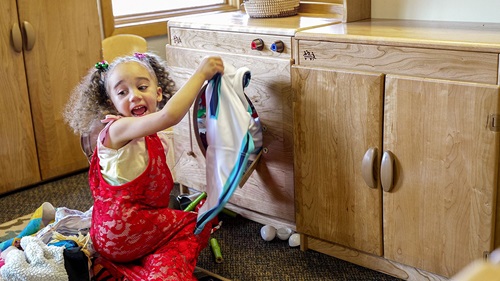Creating Boundaries in a “Yes” Environment
| February 2023Can you imagine a world without appropriate guidelines? A world where the lack of rules means people do whatever they want? It would be very difficult to live our lives without healthy boundaries and reasonable safety rules. We need a framework of guidelines to help a community function.
A classroom community also needs this framework. When setting up a “yes” environment, we need to be aware of how we can keep children safe, while allowing for them to take risks. We set children up for success by creating boundaries within which they can explore. We strive to create classroom environments where children can do the things they need to do: run, jump, build, climb, laugh, and create. This is accomplished by reflecting on our own role as the teacher, providing a safe place for risk taking, and defining clear expectations beforehand.
Reflect on the Teacher’s Role
As I discussed in “Creating a ‘Yes’ Environment”one of the roles of the teacher is to facilitate children’s play. Our job is to prepare the classroom so that it’s ready to welcome children, no matter how they might want to spend their time. We do this by making appropriate boundaries in the environment. These boundaries can be physical and obvious: the four walls of the classroom or the fence in the yard. They might be figurative and contained within the teachers themselves: our voices and our guidance creating the space in which children can freely play. Figurative boundaries might also include the agreements we make with a child to guide their interactions with other children and the classroom materials.
Another word for boundaries could be “rules” or “guidelines.” It is important to make time to consider why we choose our particular classroom guidelines. Are rules the same all the time, no matter which children are in the space? Do the rules follow developmentally appropriate practices? Were the rules created in response to one incident, like a child getting hurt, and now all future generations of children will never be able to engage in that particular play activity?
If your answer is, “It’s the way we’ve always done it,” it is definitely time to reassess whether these particular classroom guidelines are still appropriate Any rule or rules that are stressful or difficult to enforce should also be looked at. Guidelines should be created for a specific group of children and for their specific developmental stages. Based on what you know about the children in your care, the classroom guidelines might shift and evolve over time. Can you allow children to climb on the railing of the play structure in the yard once you trust them to have the gross motor strength to do so? Relying only on standard classroom rules to manage behavior disregards a teacher’s understanding of the abilities and skills the children in a group have mastered. Guidelines should always reflect the current development of the children in a classroom.
Provide a Safe Place for Risk Taking
Another job of a teacher is to provide a reasonably safe environment where children can explore without having to hear “no” all the time. What is “reasonably safe”? It would be impossible to prevent all accidents in a classroom. Somehow children manage to trip, fall, and scrape knees, no matter what we try to do to keep them from getting injured. A “reasonably safe” classroom provides opportunities for a variety of play types, while also making sure all dangers, such as broken toys, bleach bottles, or sharp adult scissors, are removed.
Such a classroom is one where risk-taking opportunities can happen safely. In looking at your classroom consider, what potential safety risks might the children encounter daily? What changes can be made to the environment to keep children safe? For example, supporting risk in the Gross Motor area might mean putting out a mattress with pillows to tumble on. In the Sensory Area you could put towels under the table so children don’t slip. When teachers take the time to set up spaces where the intention is to say “yes” whenever possible, it reduces stress for both the teacher and the children.
The most important rules in a reasonably safe classroom are for the teachers, to make sure that children don’t get hurt and that the classroom environment and materials aren’t damaged. Rules for teachers include “slow down,” “allow for joy,” and “step in when a child might get hurt.” Instead of creating long lists of rules for children to follow (“walk quietly” or “keep your hands to yourself”), a teacher should be observant and quick to respond calmly and intentionally. In this way, teachers can head off potential injury or unwanted use of materials, with a gentle reminder.
Define Expectations Beforehand
You’ve reflected on how, as a teacher, you can say “yes” more often. You’ve made sure your environment is as safe as it can be, while still allowing for risky play. Now what? Aren’t children still going to get hurt or stop following the rules?
As facilitators of “yes” play, teachers set up developmentally appropriate guidelines and then make these clear to children from the very beginning. We start the process by getting to know the group of children in our classroom, both as individuals and as a group. Once we understand where our children are in their development, and we’re familiar with their temperaments, we can begin to create classroom rules that children will be better able to accept and follow.
Understanding children’s development also allows teachers to be more aware when the rules don’t make sense. If children are feeling wiggly and can’t sit still or “be quiet and listen” during story time, perhaps it’s not the right time to be asking children to sit for a story. Some children may never be able to sit still, due to immaturity or lack of impulse control, and it is inappropriate to ask them to stop moving their bodies for a story. Instead, the teacher creates a new boundary in the classroom: If a child is ready to listen to the story, come on over; however, if a child needs to wiggle and roll around, a space is made elsewhere in the classroom for that to happen. Should the moving children want to join, they are agreeing to be a part of the group listening to the story.
This new boundary needs to be communicated to the children before a teacher starts limiting with “no.” Whether a teacher speaks one-on-one with a child or presents the boundary in a group discussion, children must be given an opportunity to hear about the classroom guidelines and to give feedback about them. Allowing for buy-in by making an agreement with children makes it easier for them to follow any kind of rules being set by the teachers.
The understanding of these guidelines will not happen overnight. Teachers and children must practice them every day. Consistency is very important if teachers want children to be aware of and be able to remember the classroom boundaries. You may have to remind a child of a particular boundary daily, perhaps even multiple times a day. Once children start to grasp that the guidelines aren’t going to change, and that there are still plenty of opportunities to play in an otherwise “yes” environment, they will begin to follow the rules on their own.
Conclusion
When the guidelines of the classroom are clear, and when children have had plenty of time to practice them, making mistakes as necessary, teachers can then start to step back and give the children the freedom to learn and play without interruption.
Creating a classroom that allows for “yes” doesn’t mean we allow children to do whatever they want. It doesn’t mean that we have no rules in the classroom environment. What it does mean is that teachers create a framework for the classroom and the children, with guidelines to assure reasonable safety. It means that we have patience with children and meet their needs in a developmentally appropriate way. In this way, we can confidently say “yes” to our children, because we’ve already created the foundation to support their explorations and play.










